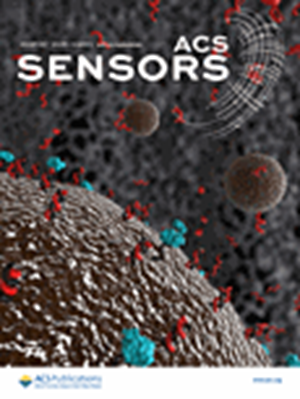Machine Learning-Enhanced Chemiresistive Sensors for Ultra-Sensitive Detection of Methanol Adulteration in Alcoholic Beverages
IF 8.2
1区 化学
Q1 CHEMISTRY, ANALYTICAL
引用次数: 0
Abstract
Methanol poisoning poses significant health risks, particularly in less developed countries, where adulterated alcoholic beverages often lead to severe morbidity and mortality. Current diagnostic methods, such as gas–liquid chromatography and blood gas analysis, are complex and prohibitively expensive, making them inaccessible in resource-constrained settings. To address this issue, we present a novel, simple, low-cost chemiresistive sensor for the rapid, selective, and ultrasensitive detection of methanol at ultralow concentrations in the presence of high ethanol concentrations. The sensor leverages an extrusion-printed hybrid composite of NU-1000 metal–organic frameworks (MOFs) and graphene, exploiting their unique structural and electronic synergies based on high porosity, functional metal sites of MOFs and graphene’s excellent conductivity that enhance sensitivity and selectivity. To further overcome challenges in selectivity, we integrated machine learning algorithms and principal component analysis (PCA), significantly improving the sensor’s ability to differentiate methanol from ethanol and other potential interferents. The extrusion printing technique ensures the fabrication of uniform, stable, and durable sensor layers on ceramic substrates, maintaining reproducible performance and stability. Our results demonstrate the sensor’s capability to detect methanol vapors at parts-per-billion (ppb) levels in the presence of higher concentration of ethanol (ppm), making it an effective tool for monitoring methanol intoxication through breath analysis. This innovative approach represents a notable advancement in gas sensing technologies, offering a scalable, cost-effective solution for applications in medical diagnostics, industrial monitoring, and consumer safety. This research highlights the potential of extrusion-printed hybrid materials in advancing gas sensing technologies to enhance public health and safety.

机器学习增强的化学电阻传感器用于酒精饮料中甲醇掺假的超灵敏检测
甲醇中毒造成严重的健康风险,特别是在欠发达国家,在这些国家,掺假的酒精饮料往往导致严重的发病率和死亡率。目前的诊断方法,如气液色谱法和血气分析,既复杂又昂贵,在资源有限的情况下无法使用。为了解决这个问题,我们提出了一种新颖、简单、低成本的化学电阻传感器,用于在高浓度乙醇存在的情况下快速、选择性和超灵敏地检测超低浓度甲醇。该传感器利用NU-1000金属有机框架(MOFs)和石墨烯的挤压印刷混合复合材料,利用其独特的结构和电子协同作用,基于高孔隙率,MOFs的功能金属位点和石墨烯的优异导电性,提高了灵敏度和选择性。为了进一步克服选择性方面的挑战,我们整合了机器学习算法和主成分分析(PCA),显著提高了传感器区分甲醇、乙醇和其他潜在干扰物的能力。挤压印刷技术确保在陶瓷基板上制造均匀、稳定和耐用的传感器层,保持可复制的性能和稳定性。我们的研究结果表明,该传感器能够在高浓度乙醇(ppm)存在的情况下检测十亿分之一(ppb)水平的甲醇蒸气,使其成为通过呼吸分析监测甲醇中毒的有效工具。这种创新的方法代表了气体传感技术的显著进步,为医疗诊断、工业监控和消费者安全领域的应用提供了可扩展的、具有成本效益的解决方案。这项研究突出了挤压印刷混合材料在推进气体传感技术以增强公共健康和安全方面的潜力。
本文章由计算机程序翻译,如有差异,请以英文原文为准。
求助全文
约1分钟内获得全文
求助全文
来源期刊

ACS Sensors
Chemical Engineering-Bioengineering
CiteScore
14.50
自引率
3.40%
发文量
372
期刊介绍:
ACS Sensors is a peer-reviewed research journal that focuses on the dissemination of new and original knowledge in the field of sensor science, particularly those that selectively sense chemical or biological species or processes. The journal covers a broad range of topics, including but not limited to biosensors, chemical sensors, gas sensors, intracellular sensors, single molecule sensors, cell chips, and microfluidic devices. It aims to publish articles that address conceptual advances in sensing technology applicable to various types of analytes or application papers that report on the use of existing sensing concepts in new ways or for new analytes.
 求助内容:
求助内容: 应助结果提醒方式:
应助结果提醒方式:


